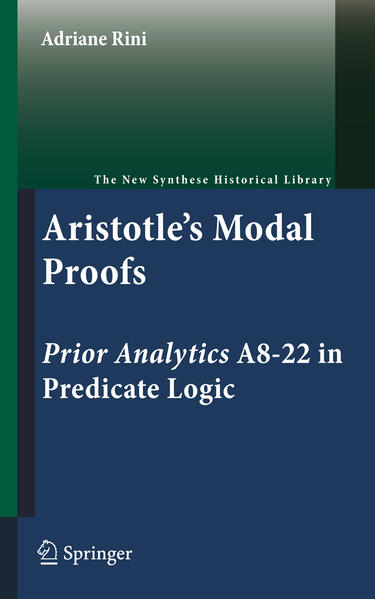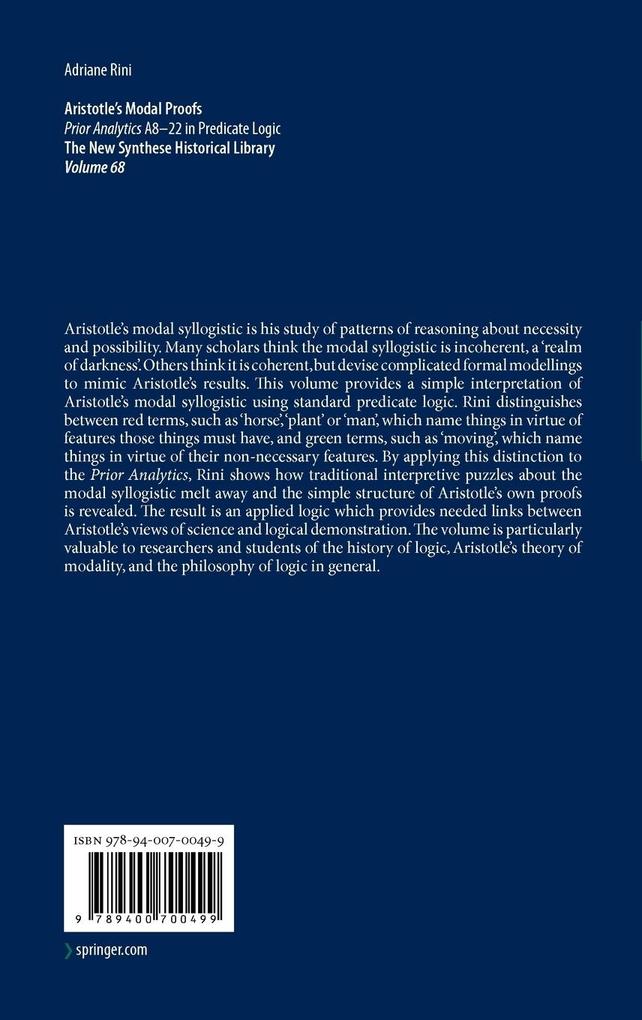
Zustellung: Fr, 18.07. - Mi, 23.07.
Versand in 2 Wochen
VersandkostenfreiBestellen & in Filiale abholen:
Aristotle's modal syllogistic is his study of patterns of reasoning about necessity and possibility. This volume provides a simple interpretation of Aristotle's modal syllogistic using standard predicate logic, making it accessible to a wide range of readers.
Aristotle s modal syllogistic is his study of patterns of reasoning about necessity and possibility. Many scholars think the modal syllogistic is incoherent, a `realm of darkness . Others think it is coherent, but devise complicated formal modellings to mimic Aristotle s results. This volume provides a simple interpretation of Aristotle s modal syllogistic using standard predicate logic. Rini distinguishes between red terms, such as `horse , `plant or `man , which name things in virtue of features those things must have, and green terms, such as `moving , which name things in virtue of their non-necessary features. By applying this distinction to the Prior Analytics, Rini shows how traditional interpretive puzzles about the modal syllogistic melt away and the simple structure of Aristotle s own proofs is revealed. The result is an applied logic which provides needed links between Aristotle s views of science and logical demonstration. The volume is particularly valuable to researchers and students of the history of logic, Aristotle s theory of modality, and the philosophy of logic in general.
Inhaltsverzeichnis
Acknowledgements. - Introduction. - Part I: Modern Methods for Ancient Logic. - 1. The Non-Modal Syllogistic: An. Pr. A1-7. - 2. The Assertoric Syllogistic in LPC. - 3. A Realm of Darkness. - 4. Technicolour Terms. - 5. Representing Modality. - Part II: Necessity in the Syllogistic: An. Pr. 8-12. - 6. Syllogizing in Red: Trivializing the Modals. - 7. First-Figure Mixed Apodeictic Syllogisms. - 8. Modal Conversion in the Apodeictic Syllogistic. - 9. Against the Canonical Listings. - 10. Apodeictic Possibility. - Part III: Contingency in the Syllogistic: An. Pr. 13-22. - 11. Contingency (A13, A14). - 12. Realizing Possibilities. - 13. Barbara XQM. - 14. First Figure X+Q (A15). - 15. First Figure L+Q, Q+L (A16). - 16. Contingency in the 2nd Figure (A17, A18, A19). - 17. Contingency in the 3rd Figure (A20, A21, A22). - 18. Summary and Conclusion. - Appendix: The LPC Framework. - Bibliography. - Index.
Produktdetails
Erscheinungsdatum
18. Dezember 2010
Sprache
englisch
Auflage
2011 edition
Seitenanzahl
246
Reihe
The New Synthese Historical Library
Autor/Autorin
Adriane Rini
Verlag/Hersteller
Produktart
gebunden
Gewicht
514 g
Größe (L/B/H)
244/167/18 mm
ISBN
9789400700499
Entdecken Sie mehr
Bewertungen
0 Bewertungen
Es wurden noch keine Bewertungen abgegeben. Schreiben Sie die erste Bewertung zu "Aristotle's Modal Proofs" und helfen Sie damit anderen bei der Kaufentscheidung.










